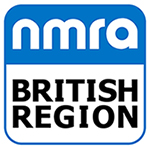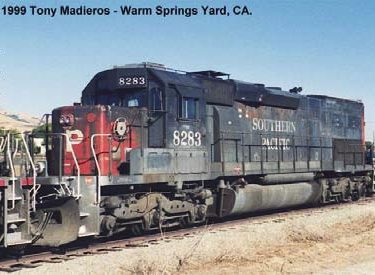By Mike Arnold; prototype photographs by the author and Tony Madieros
First published in August 2007 Roundhouse
Introduction
I guess we all have our favourite locos, eras, liveries etc – for me it is the SD40T-2 by EMD, the later of the two classic tunnelmotor models (the other is the SD45T-2 available in the Athearn RTR range in highly detailed and accurate form). And it is a very simple reason – this was the very first North American outline model loco I bought in 1994, whilst on a trip to Disneyworld, Florida, at the old Train Depot store owned by the late Stew Marshall. Heaven knows how or why I chose it then as hobby stores back then stocked everything Athearn had listed and the Train Depot was no exception.
So it started with SP #8490 in speed lettering. Then I got into detailing and spotting the differences between production batches and so kitbashing started in earnest with this first tunnelmotor. My previous article on SP’s GP40s highlighted the need for good photos as reference material. The SD40T-2 is no exception – three different noses; and two different styles of: jacking pads, brake systems, antenna stand positions, anti-climber styles and dynamic brake blister types. This article sets out the detail parts and work needed to give you a good model of a prototype still plying its trade across the pond, albeit mainly in lease fleets. Even FEC in Florida is taking delivery of some remanufactured ones and rumour has it that some are already running for Helm Leasing (HLCX) on CSX – no excuses now, Martin! At least two are in Cornell red and look distinctly Lehigh Valley! That’s got Tom Winlow’s attention too.
The original “blue box” model is now out of production but secondhand examples come up from time to time – I got one from Mike Rimes at the Wokingham Meet a few years back. Out of the box only the Denver & Rio Grande Western one is close to being right but this article concentrates mainly on SP and Cotton Belt (SSW) versions. However there are strong rumours that the SD40T-2 (along with the SD40-2) will be the next to get the upgrade treatment from Athearn later this year or early 2008. [Author’s Note: article was written before the revised and very updated SD40T-2 model was produced – which is still in production in 2014].
The prototype
Tunnelmotors were produced in the following batches:
1. 1974 – #8300-06 and #8350-56 – snoots with 116 inch noses and ratchet brake system (Cannon part 1105), angled anti-climber (Cannon part 2102) with antenna stands placed centrally behind the cab roof like on SD45T-2s (Details West part DW223), a full SP light array in the nose only (Sunrise Enterprises SRE part 13114), T-shaped jacking pads (per the Athearn model), cab roof vent (DA 1903) on the left hand slope and the bell on the cab roof (DA part 1201). [See Photo 1]
2. 1978/79 – #8307-8341; 8357-8391 – snoots with 123 inch noses with hand wheel brakes (Cannon part 1106), rounded anti-climber (per Athearn model; Cannon part 2103), antenna stands on left side of exhaust stack (DW part 222), a full SP light array on nose and rear (SRE part 13113
with full lights or 13112 with only lower twin lights), 4-hole jacking pads (Cannon part 2151) and bell on the cab roof.
3. 1978 – #8489-8498 – as in the second batch but with 88 inch noses (Cannon part 1104). [see Photo 2]
4. 1978-79 – #8499-8573 – as in previous batch but with the bell mounted on the underframe in front of fuel tank on lefthand side (DA part 1202).
5. 1980 – #8230-8299 – as in previous batch but with a different dynamic brake blister – a more bulbous shape to accommodate additional ducting and wiring on these models – some of the later Athearn SD40-2s with plastic handrails had these – I swapped one out from an ATSF one for my model (Athearn part 48040). [see Photos 3, 4 and 7]


1. Left: 1974 version #8355 with early details – ratchet brake; air vent on cab roof, bell on roof, repainted in speed lettering.
2. Right: Standard 88 inch nose #8496, note bell on roof and anti-climber


3. Left: UP patch #8850 with bulbous dynamic brake.
4. Right: SP #8261 repainted by Roseville shops after UP acquisition! Note no wings and use of SP nose decal on long hood
In addition to the above locos #8322-26 were lettered for Cotton Belt/SSW (Athearn produced #8326 in SP!).
Over time, ditchlights became a requirement and some of the lights were removed, particularly the red Mars lights, classification lights and the ‘gyralites’ above the cab front. Horns were also moved from the cab roof to the long hood on the lefthand side behind the dynamic brake blister.
The models
Having established the differences, we can now concentrate on the standard details. Despite the way the short nose version comes from Athearn, all tunnelmotors had anti-climbers on the front (as well as rear, per Athearn models). Tunnelmotors were all fitted with “Vapor” air conditioner units (Detail Associates part 2309) on the roof (though UP began fitting “Prime” air conditioners post-1996 (DA part 2308)) along with two small antenna stands just to rear of the a/c unit (no commercially available parts) with whip aerial bases (DA part 1802).
Ducting for wiring to antenna stands is shaped from 0.033mm wire secured in place through eye bolts (DA 2206). The distinctive handrail at the back end of the lefthand side of the long hood is bent from 0.033mm wire and again secured with two eyebolts. [See Photo 5] Lift rings can be added for additional details using that same part in #74 holes drilled where the raised pips are on the exhaust hatch and brake blister. I also applied an additional piece of ribbing cut from 5 thou plasticard strip 1mm wide on the top of the long hood, from the rear of the dynamic brake blister back to the leading edge of the roof grille section. Additional eyebolts for lift rings were applied just forward of the rearmost roof panel break, on the outer corners, and the third was applied just behind the middle panel break just to the right of the new plasticard central rib (see rooftop shots). The dynamic brake blister vent is also the wrong shape and in the wrong position – all of my earlier detailing jobs did not pick this up but the latest ones have – see photos to show it farther back, not quite on the blister itself at all! New part DA1904 replaces the Athearn moulding. [See Photo 6]


5. Left: Snoot #8362 – note rear light array and horn placement.
6. Right: Details going on to #8355.
With all hand braked Athearn noses I have replaced the wheel with the Cannon part 1108 as this is far better looking. The short nose Athearn models need notches cut on the front to take the SP light packages – indeed so do Cannon noses. Only the Athearn snoot version comes with SP lights on the nose. On all of my models bar one, I have cut out the distinctive trademark air intake grilles and replaced them with etched ones by A1 Models (MG Sharp are their sole agents). The one on the SD45T-2 is far better but….needs must. However with two damaged SD45T-2s acquired cheap lurking in my spares box, you never know…
Other additional details needed are:
• wire grabs for the nose and rear hood (DA 2202);
• m.u. hoses on front and rear (DW266);
• coupler lift bars (DA 2211/12 on the front and DA 2204/5 n the rear) secured through eyebolts in pre-drilled holes;
• cab shades, my preference being A-Line part 29210;
• SP plow (DW 233);
• SP ditchlights (DA 1027) with MV lenses superglued in place;
The fuel tank could do with a lot of detailing – Cannon kit 2156 fits the bill but good photos for the detail are hard to come by. And you do need them. Alternatively you could mount the body on a spare SD45T-2 chassis or even an SD50 which is what I did with #8355. [See Photos 3 and 7] You could also now replace the roof top fans with Cannon parts to get that latest see through look (as on the current SD45T-2s) but I have rather too many now to do that to, apart from my latest addition #8650 in UP patch …[See Photo 8]


7. Left: SP #8283 looking that traditional tired way, in need of some TLC. This proved to be the last unpatched SP tunnelmotor and is still like this at Roseville today on the dead line.
8. Right: UP patch #8650, snoot version.
If all the above seems a bit daunting, you could try a very cheap detailing job. The DRGW ones (88 inch noses) are almost 100% accurate as they come. All you need to add are just the mu hoses, grabirons and handrail on rear of long hood detailed above, plus the plow (DW 155), the etched air intake grilles, a Sinclair antenna on the roof (DW274/DA1803/101803), bell mounted on the underframe and a flat filed onto the nose to accommodate an oscillating nose light package (DA 1009). [See Photo 9] The only other parts unique to DRGW locos were drop steps (DA 1402) and an additional equipment cabinet behind the existing moulded one (see model photo of UP #2888). [See Photos 10 and 11] These were fitted in the mid-1980s. This was fashioned from 10 thou plasticard.


9. Left: Ex-DRGW in UP patch as #8632 and sold to GECX (UP branding deleted)
10. Right: Ex-DRGW repainted as UP #2888 (note additional electrical cabinet behind cab)
Some locos were repainted into SP speed lettering, so just add the above and, for an SP one, ditchlights, and, voila, you have a quick and easy detailing job done. This works as well for full UP repainted short nose ones too, though many had the noses remodelled back to standard, making it an even easier conversion – again see model photo of UP #2888. [See Photo 11] At least one made it into the latest livery depicting the “wings” made famous on E units. This again proves the value of using photographs for accuracy and uniqueness. [See Photo 12]


11. Left: Details going on to #2888.
12. Right: Ex-DRGW now UP repaint uniquely with “wings” and lightening flash lining
So there is my life with tunnelmotors – I have now detailed about twenty of them and no two are the same, such are the differences. I am now dreading Athearn announcing formally that they are re-introducing the model but retooled to the standard of the SD45T-2 or as a Genesis range model, possibly with sound. Ouch!
My thanks to Tony Madieros for his permission to use his photos
Post script After writing this article I discovered that Sunrise Enterprises have stopped manufacturing their whitemetal detail parts wef 1/1/07. This is a real pity as their products are excellent – perhaps they will sell those lines on. Details West do provide some light packages but only the complete ones but you never know what future production will bring.



